1. Bhattacharya PT, Misra SR, Hussain M. Nutritional aspects of essential trace elements in oral health and disease: an extensive review. Scientifica (Cairo). 2016; 2016:5464373. PMID:
27433374.

2. Wessling-Resnick M. Iron homeostasis and the inflammatory response. Annu Rev Nutr. 2010; 30(1):105–122. PMID:
20420524.

3. Wang J, Pantopoulos K. Regulation of cellular iron metabolism. Biochem J. 2011; 434(3):365–381. PMID:
21348856.

4. Jankowska EA, von Haehling S, Anker SD, Macdougall IC, Ponikowski P. Iron deficiency and heart failure: diagnostic dilemmas and therapeutic perspectives. Eur Heart J. 2013; 34(11):816–829. PMID:
23100285.

5. Jankowska EA, Rozentryt P, Witkowska A, Nowak J, Hartmann O, Ponikowska B, et al. Iron deficiency predicts impaired exercise capacity in patients with systolic chronic heart failure. J Card Fail. 2011; 17(11):899–906. PMID:
22041326.

6. Stugiewicz M, Tkaczyszyn M, Kasztura M, Banasiak W, Ponikowski P, Jankowska EA. The influence of iron deficiency on the functioning of skeletal muscles: experimental evidence and clinical implications. Eur J Heart Fail. 2016; 18(7):762–773. PMID:
26800032.

7. Price EA, Mehra R, Holmes TH, Schrier SL. Anemia in older persons: etiology and evaluation. Blood Cells Mol Dis. 2011; 46(2):159–165. PMID:
21208814.

8. Barton JC, Wiener HH, Acton RT, Adams PC, Eckfeldt JH, Gordeuk VR, et al. Prevalence of iron deficiency in 62,685 women of seven race/ethnicity groups: the HEIRS Study. PLoS One. 2020; 15(4):e0232125. PMID:
32324809.

9. Hughes CM, Woodside JV, McGartland C, Roberts MJ, Nicholls DP, McKeown PP. Nutritional intake and oxidative stress in chronic heart failure. Nutr Metab Cardiovasc Dis. 2012; 22(4):376–382. PMID:
21186107.

10. Naito Y, Tsujino T, Fujimori Y, Sawada H, Akahori H, Hirotani S, et al. Impaired expression of duodenal iron transporters in Dahl salt-sensitive heart failure rats. J Hypertens. 2011; 29(4):741–748. PMID:
21191310.

11. Satoh M, Minami Y, Takahashi Y, Nakamura M. Immune modulation: role of the inflammatory cytokine cascade in the failing human heart. Curr Heart Fail Rep. 2008; 5(2):69–74. PMID:
18765076.

12. Klip IT, Comin-Colet J, Voors AA, Ponikowski P, Enjuanes C, Banasiak W, et al. Iron deficiency in chronic heart failure: an international pooled analysis. Am Heart J. 2013; 165(4):575–582.e3. PMID:
23537975.

13. Jankowska EA, Rozentryt P, Witkowska A, Nowak J, Hartmann O, Ponikowska B, et al. Iron deficiency: an ominous sign in patients with systolic chronic heart failure. Eur Heart J. 2010; 31(15):1872–1880. PMID:
20570952.

14. Anand I. Iron deficiency in heart failure. Cardiology. 2014; 128(4):317–319. PMID:
24923867.

15. Varma A, Appleton DL, Nusca A, Lipinski MJ, Goudreau E, Cowley MJ, et al. Iron deficiency anemia and cardiac mortality in patients with left ventricular systolic dysfunction undergoing coronary stenting. Minerva Cardioangiol. 2010; 58(1):1–10. PMID:
20145590.
16. Magrì D, De Martino F, Moscucci F, Agostoni P, Sciomer S. Anemia and iron deficiency in heart failure: clinical and prognostic role. Heart Fail Clin. 2019; 15(3):359–369. PMID:
31079694.
17. Anker SD, Kirwan BA, van Veldhuisen DJ, Filippatos G, Comin-Colet J, Ruschitzka F, et al. Effects of ferric carboxymaltose on hospitalisations and mortality rates in iron-deficient heart failure patients: an individual patient data meta-analysis. Eur J Heart Fail. 2018; 20(1):125–133. PMID:
28436136.

18. Anker SD, Comin Colet J, Filippatos G, Willenheimer R, Dickstein K, Drexler H, et al. Ferric carboxymaltose in patients with heart failure and iron deficiency. N Engl J Med. 2009; 361(25):2436–2448. PMID:
19920054.

19. Ponikowski P, Kirwan BA, Anker SD, McDonagh T, Dorobantu M, Drozdz J, et al. Ferric carboxymaltose for iron deficiency at discharge after acute heart failure: a multicentre, double-blind, randomised, controlled trial. Lancet. 2020; 396(10266):1895–1904. PMID:
33197395.
20. Ponikowski P, van Veldhuisen DJ, Comin-Colet J, Ertl G, Komajda M, Mareev V, et al. Beneficial effects of long-term intravenous iron therapy with ferric carboxymaltose in patients with symptomatic heart failure and iron deficiency. Eur Heart J. 2015; 36(11):657–668. PMID:
25176939.

21. Park JJ, Lee CJ, Park SJ, Choi JO, Choi S, Park SM, et al. Heart failure statistics in Korea, 2020: a report from the Korean Society of Heart Failure. Int J Heart Fail. 2021; 3(4):224–236. PMID:
36262554.

22. Kim KJ, Cho HJ, Kim MS, Kang J, Kim KH, Kim D, et al. Focused update of 2016 Korean Society of Heart Failure guidelines for the management of chronic heart failure. Int J Heart Fail. 2019; 1(1):4–24. PMID:
36262736.

23. McDonagh TA, Metra M, Adamo M, Gardner RS, Baumbach A, Böhm M, et al. 2021 ESC guidelines for the diagnosis and treatment of acute and chronic heart failure. Eur Heart J. 2021; 42(36):3599–3726. PMID:
34447992.

24. Heidenreich PA, Bozkurt B, Aguilar D, Allen LA, Byun JJ, Colvin MM, et al. 2022 AHA/ACC/HFSA guideline for the management of heart failure: a report of the American College of Cardiology/American Heart Association Joint Committee on Clinical Practice Guidelines. J Am Coll Cardiol. 2022; 79(17):e263–e421. PMID:
35379503.
25. Parikh A, Natarajan S, Lipsitz SR, Katz SD. Iron deficiency in community-dwelling US adults with self-reported heart failure in the National Health and Nutrition Examination Survey III: prevalence and associations with anemia and inflammation. Circ Heart Fail. 2011; 4(5):599–606. PMID:
21705484.

26. Yeo TJ, Yeo PS, Ching-Chiew Wong R, Ong HY, Leong KT, Jaufeerally F, et al. Iron deficiency in a multi-ethnic Asian population with and without heart failure: prevalence, clinical correlates, functional significance and prognosis. Eur J Heart Fail. 2014; 16(10):1125–1132. PMID:
25208495.

27. Beale A, Carballo D, Stirnemann J, Garin N, Agoritsas T, Serratrice J, et al. Iron deficiency in acute decompensated heart failure. J Clin Med. 2019; 8(10):1569. PMID:
31581494.

28. Rocha BM, Cunha GJ, Menezes Falcão LF. The burden of iron deficiency in heart failure: therapeutic approach. J Am Coll Cardiol. 2018; 71(7):782–793. PMID:
29447741.
29. Tsai TT, Ho PM, Xu S, Powers JD, Carroll NM, Shetterly SM, et al. Increased risk of bleeding in patients on clopidogrel therapy after drug-eluting stents implantation: insights from the HMO Research Network-Stent Registry (HMORN-stent). Circ Cardiovasc Interv. 2010; 3(3):230–235. PMID:
20442361.

30. van der Wal HH, Grote Beverborg N, Dickstein K, Anker SD, Lang CC, Ng LL, et al. Iron deficiency in worsening heart failure is associated with reduced estimated protein intake, fluid retention, inflammation, and antiplatelet use. Eur Heart J. 2019; 40(44):3616–3625. PMID:
31556953.

31. von Haehling S, Ebner N, Evertz R, Ponikowski P, Anker SD. Iron deficiency in heart failure: an overview. JACC Heart Fail. 2019; 7(1):36–46. PMID:
30553903.
32. van Veldhuisen DJ, Anker SD, Ponikowski P, Macdougall IC. Anemia and iron deficiency in heart failure: mechanisms and therapeutic approaches. Nat Rev Cardiol. 2011; 8(9):485–493. PMID:
21629210.

33. Anand IS, Gupta P. Anemia and iron deficiency in heart failure: current concepts and emerging therapies. Circulation. 2018; 138(1):80–98. PMID:
29967232.
34. Park YJ, Kim HS, Kang HC. The age at menopause and related factors in Korean women. J Korean Acad Nurs. 2002; 32(7):1024–1031.

35. Aigner E, Feldman A, Datz C. Obesity as an emerging risk factor for iron deficiency. Nutrients. 2014; 6(9):3587–3600. PMID:
25215659.

36. Zhao L, Zhang X, Shen Y, Fang X, Wang Y, Wang F. Obesity and iron deficiency: a quantitative meta-analysis. Obes Rev. 2015; 16(12):1081–1093. PMID:
26395622.

37. McClung JP, Karl JP. Iron deficiency and obesity: the contribution of inflammation and diminished iron absorption. Nutr Rev. 2009; 67(2):100–104. PMID:
19178651.

38. Kang SH, Park JJ, Choi DJ, Yoon CH, Oh IY, Kang SM, et al. KorHF Registry. Prognostic value of NT-proBNP in heart failure with preserved versus reduced EF. Heart. 2015; 101(23):1881–1888. PMID:
26319121.

39. Kim MS. The long journey to obtaining the epidemiological data of heart failure in Korea. Int J Heart Fail. 2021; 3(4):221–223. PMID:
36262559.

40. Lewis GD, Malhotra R, Hernandez AF, McNulty SE, Smith A, Felker GM, et al. Effect of oral iron repletion on exercise capacity in patients with heart failure with reduced ejection fraction and iron deficiency: the IRONOUT HF randomized clinical trial. JAMA. 2017; 317(19):1958–1966. PMID:
28510680.

41. Lim EA, Sohn HS, Lee H, Choi SE. Cost-utility of ferric carboxymaltose (Ferinject
®) for iron-deficiency anemia patients with chronic heart failure in South Korea. Cost Eff Resour Alloc. 2014; 12(1):19. PMID:
25278814.
42. Lee SE, Lee HY, Cho HJ, Choe WS, Kim H, Choi JO, et al. Clinical characteristics and outcome of acute heart failure in Korea: results from the Korean Acute Heart Failure Registry (KorAHF). Korean Circ J. 2017; 47(3):341–353. PMID:
28567084.

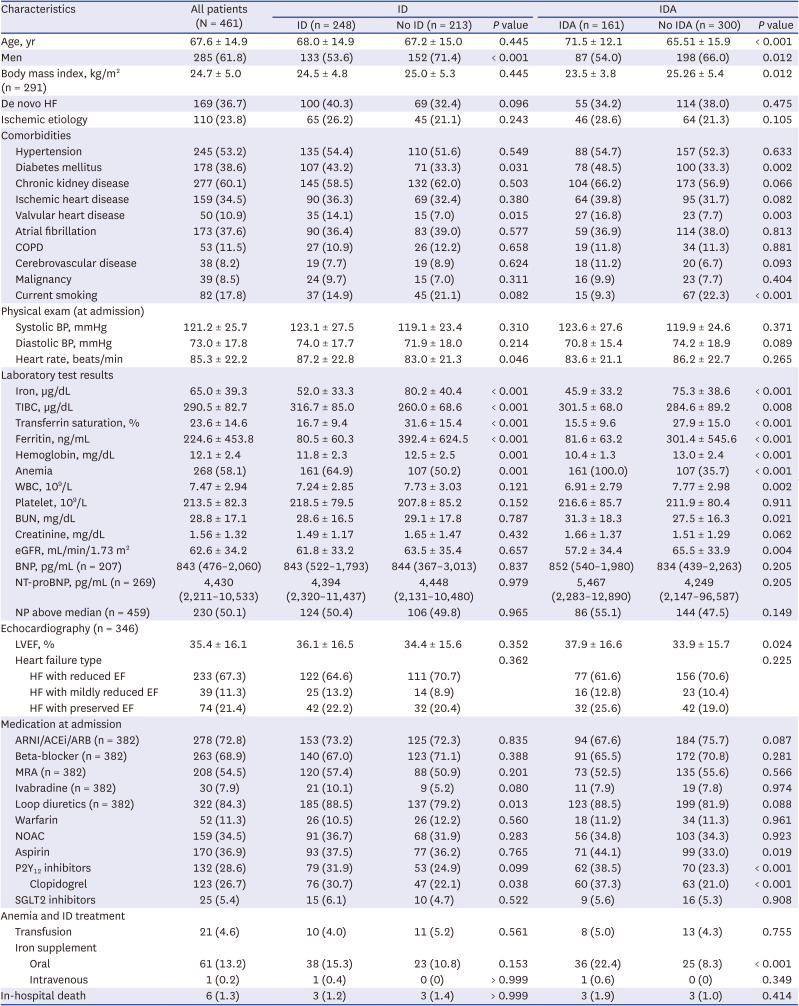
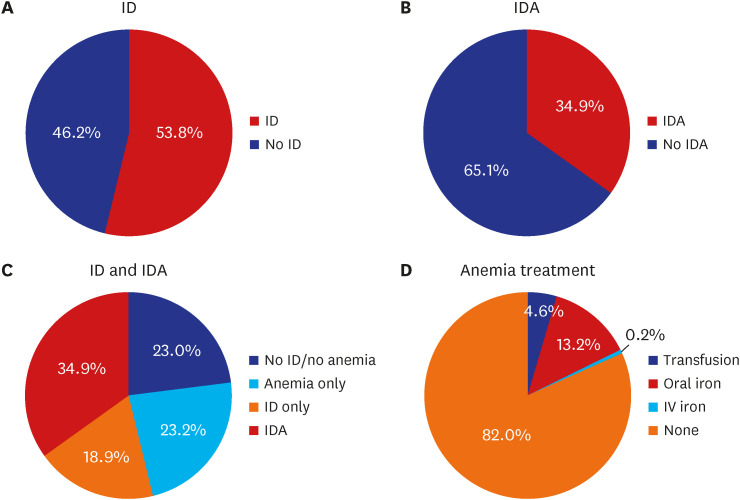
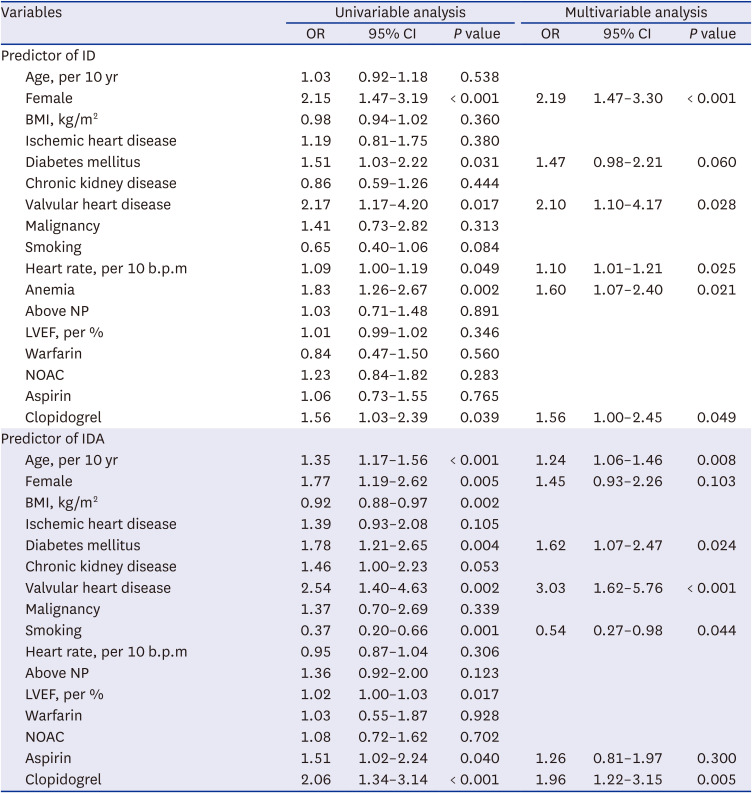
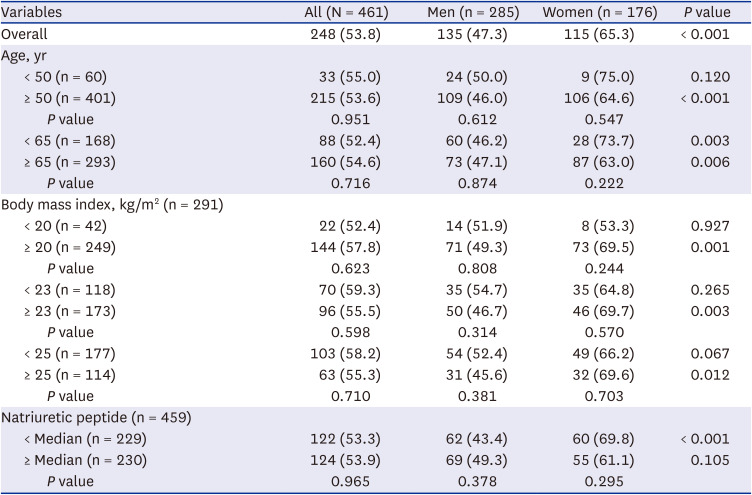
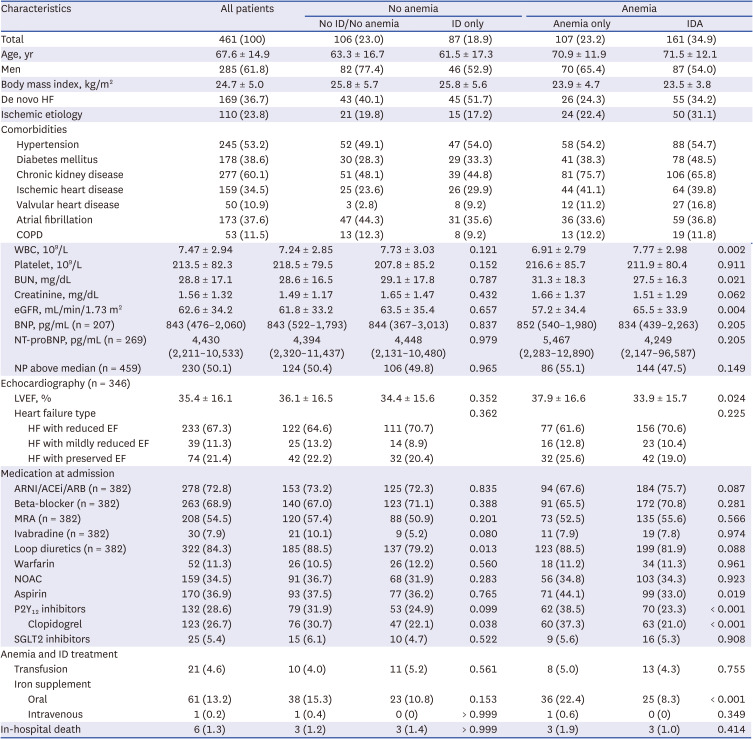




 PDF
PDF Citation
Citation Print
Print



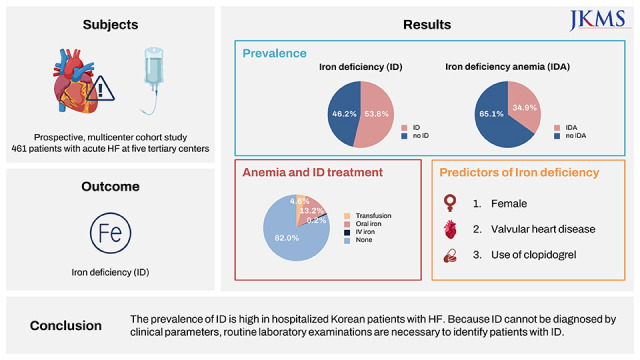
 XML Download
XML Download